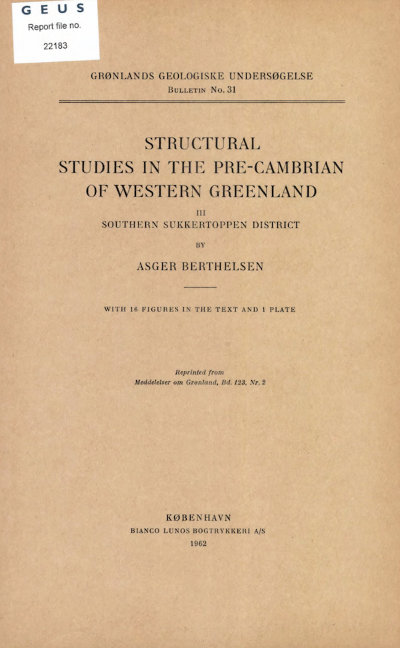Structural studies in the pre-Cambrian of western Greenland. Part III. Southern Sukkertoppen District
DOI:
https://doi.org/10.34194/bullggu.v31.6565Abstract
This paper summarises several summers field work within the southern Sukkertoppen district. Since detailed mapping has only been carried out within smaller areas within the region, the remainder being covered by reconnaissance mapping along the coasts, the results should be considered as preliminary. The southern Sukkertoppen district can be divided into three tectonic units, the Nordland, the Finnefjeld, and the Alángua complexes, which, most probably, were formed during the Ketilidian cycle (E. Wegmann, 1938). The metamorphic complexes are traversed by postorogenic dykes and faults (Berthelsen and Bridgwater, 1960). The dykes and faults were seemingly formed before the Nagssugtôqidian revolution which affected the country further to the north (Ramberg, 1948). The northern Nordland complex is shown to have passed through a metamorphic and structural evolution very similar to that which recently has been described from a small area within the complex (see table 2). An original granulite facies rock assemblage has been exposed to two successive imprints of retrograde metamorphism: first an amphibolite facies metamorphism; next a postorogenic epidote-amphibolite to greenschist facies metamorphism in connection with the formation of the younger faults. Evidence is brought forward that the tectonic phases established from Tovqussap nunâ may also be traced within the remaining parts of the Nordland complex. In one case (see fig. 3) an analysis of the basement structures reveals that the post-orogenic faulting is of the wrench fault type. The Finnefjeld complex which is built up of homogeneous hornblende-biotite-bearing quartz-dioritic gneisses is believed to have been originally composed of granulite facies rocks. Subsequent strong penetrative movements accompanied by low grade amphibolite facies metamorphism were responsible for the formation of the present Finnefjeld gneisses. This idea is strongly supported by the facts that relic patches of hypersthene gneiss and transgressive, but deformed, more or less uralitised diorite bodies occur within the Finnefjeld gneiss. The Alangua complex comprises abundant pelitic and semipelitic schists, amphibolites, ultrabasics and skarn rocks in addition to gneisses which are considered to be of metasomatic origin. The ultrabasic rocks have been described by H. Sørensen (1952,1953, 1954, and 1955). The rocks of this complex can also be shown to have passed through two periods of metamorphism (see also H. Sørensen, 1952); an original medium to high grade amphibolite facies metamorphism was succeeded by a later low grade amphibolite facies metamorphism accompanied by granitisation, pegmatisation etc., indicating the presence of a volatile-rich dispersed phase. Although not studied in detail, the structures of the Alángua complex are sufficiently well-known to establish the kinematic evolution of this complex. The first amphibolite facies metamorphism seems to correspond to the Smalledal-Pâkitsoq phases of the Nordland complex, while the subsequent period of low grade amphibolite metamorphism can be matched with the posthumous phase. During this latter, the northern part of the Nordland complex, which locally was thrust over the Alángua rocks (thereby causing their refolding) was converted into the present Finnefjeld gneisses. This interpretation explains the present differences between the three com· plexes as being due to Stockwerk tectonics, fig. 16. An alternative theory which holds that the Alángua rocks are younger than those of the southern complexes does not seem to concur with the field relation known so far. No mineral deposits of economic interest were found during the survey, but traces of sulfides (see tables 1 and 3), magnetite, molybdenite, corundum, monazite, zircon, talc and soapstone have been met with at various localities.
Downloads
Published
Issue
Section
License
This article is distributed under a CC-BY 4.0 licence, permitting free redistribution and reproduction for any purpose, even commercial, provided proper citation of the original work. Author(s) retain copyright over the article contents.


